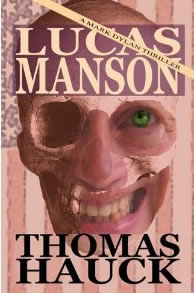Roxy joined the conversation. "We need to work this out," she said firmly. "We've got to find a way to feed ourselves on extended tours without leaving a trail of carcasses behind us. I heard they found the ones in Detroit and Miami. Sooner or later some junior detective is going to stick some pins in a map and make the connection. Dumping these things in a harbor or a vacant lot is not going to work. Even if they happen to find one, we've got to make sure that there is nothing linking the carcasses to us."
Reading Thomas Hauck's novel Lucas Manson is like sitting in one of those taxing corporate meetings that should have died at the sixty-minute mark but still lingers on well past it; and you need to take a bio-break badly; and there's no more coffee; and somebody needs to say something that brings closure and quickly. I'm exaggerating somewhat, but I've read very few novels that force me to skim pages because of their lengthy 'corporate meeting' styled discussions blowing off the action with 'tell me' instead of more preferable 'show me' exposition; leaving me with feeling the payoff--the all important underpinning that justifies a story's events and characters--doesn't add up. There is not enough suspense written in to make it a thriller; not enough horror described to make it frightening; and worse, not much excitement to be garnered from the characters and their actions. Lucas Manson's structure is more draft-stage than print-ready.
Mark Dylan is a junior member of the FBI's Special Case Unit in Boston. We first meet him while he's working undercover as a mobster for the Bunker Hill Gang. His cover is blown when he's asked to rub out another member of the gang, but winds up killing the boss man instead. This has nothing to do with Lucas Manson, the title character, a charismatic preacher who runs the Kingdom Seven Temple. We meet up with Manson after two bodies, drained of blood, are fished from Boston Harbor. When it's discovered they show similar puncture marks with others found in San Francisco, San Diego, and Kansas City, Dylan gets involved. Manson's real name is Hiram Leary, he's forty-three years old, born in Syracuse, and he and his temple followers like to suck human blood, leaving dessicated corpses behind. He's also narcissistic and not very good at covering his murderous activities because that's how Dylan eventually connects the dots: the two bodies fished from Boston Harbor were a male and female in their early twenties, last seen at one of Manson's public appearance fawnathons.
Hauck devotes many pages to Manson's ministrations with his board of directors, describing their temple business and political infighting in a way that's as interesting to read as a corporate meeting's minutes. More pages are devoted to Manson explaining his temple's mission statement, using Scientologist-like ideology. When Dylan finally meets Manson to ask him a few questions not much happens; no tension, no innuendo, no inkling of potential conflict to come.
Dylan takes a trip to Egypt based on one email from a stranger, an antiquarian book dealer in Luxor, who wants to show him some hieroglyphics he says will explain the murders. Dylan hops a flight after quickly convincing his boss it's worth a trip. In Egypt, and after another lengthy discussion of ancient history with the book dealer, a trip to the Valley of the Kings provides a modicum of gunfire and danger. Back in the States, both Dylan and Manson reconnect over more killings. More explanations ensue when Dylan meets the antiquarian book dealer's daughter, who explains what Manson and his cult followers are--and it's not human.
While the novel's premise is intriguing its pummeled to a shapeless pulp by the suspense-bleeding, pedantic writing and an unfocused and bland narrative, not helped by the mechanical dialog coming from characters who fail to concern us.
A digital copy of Lucas Manson was provided for this review




Comments